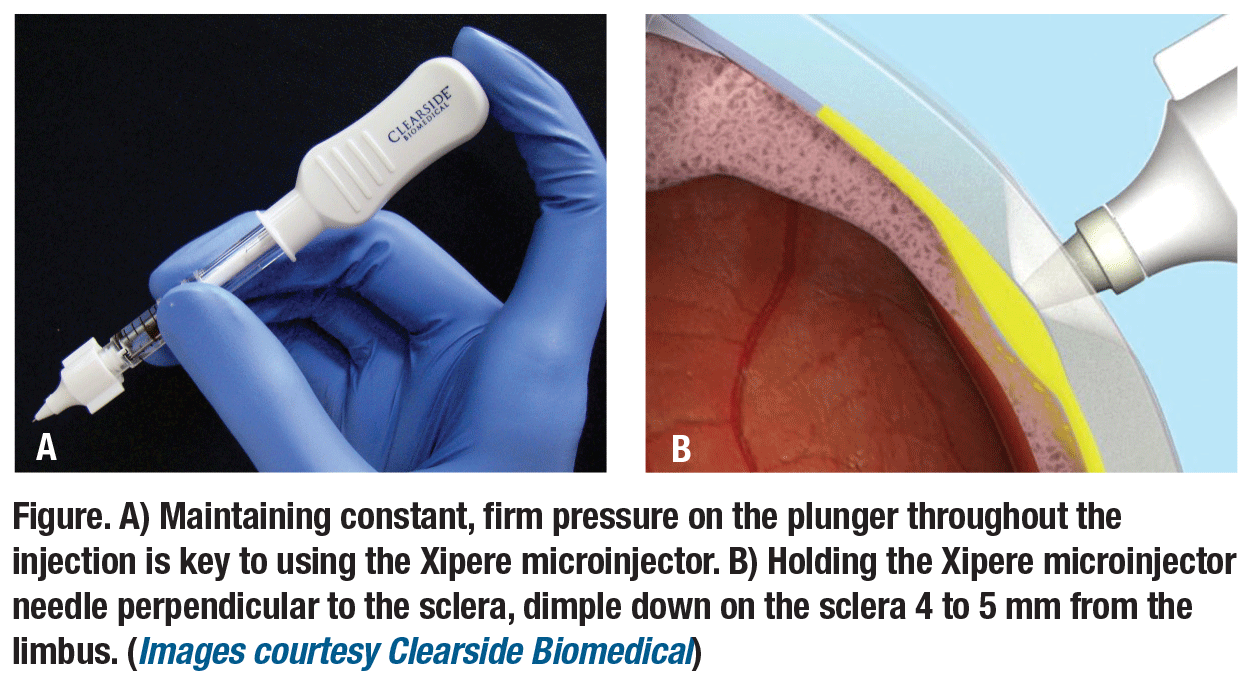
 |
Xipere (Clearside Biomedical) is triamcinolone acetonide ophthalmic suspension for suprachoroidal injection. It met its primary endpoint in Phase III trials for macular edema associated with uveitis and Phase II study for diabetic macular edema. In February, the Food and Drug Administration accepted the new drug application for the uveitis indication and assigned a Prescription Drug User Fee Act date of October 19.
Xipere is delivered to the suprachoroidal space using a proprietary injector for the treatment of macular edema associated with noninfectious uveitis. The advantage of targeting the suprachoroidal space is that it distributes the drug more directly to the retina and choroid, sparing the anterior chamber. This delivers higher drug concentrations to the parts of the eye where it is most needed, with the potential to decrease the negative side effects typical of steroid therapy, such as cataract formation and increased intraocular pressure.

Three key principles for use
While the injector is designed to facilitate the safe delivery of triamcinolone to the suprachoroidal space, the technique does differ from your typical intravitreal injection. When administering Xipere, three principles are paramount:
Hold the injector perpendicular to the sclera.
Maintain constant, firm pressure on the plunger throughout (Figure A) and dimple down on the sclera (Figure B),
Inject slowly and consistently.
Here, I’ll discuss the process of administering Xipere in the clinic.
Patient prep
 |
As a frame of reference, it may help to understand how a Xipere injection differs from an intravitreal triamcinolone injection.
While I typically use subconjunctival lidocaine for most of my IVT as a matter of preference, I find it more important for the suprachoroidal injection, as the whole process does take somewhat longer. I find the use of a lid speculum optional for IVT in most patients, as I am able to isolate the lids with my free hand.
With Xipere, the injector is designed with a two-handed approach in mind; thus I find the speculum to be very helpful. While holding the injector like a pen in my dominant hand and applying and maintaining gentle, but firm, pressure on the plunger with the other, the speculum plays a critical role in keeping the lids at bay.
The first time receiving a Xipere injection, patients don’t know what to expect. It may be helpful to have a brief dialog with them. Some patients may notice a degree of injection-site discomfort, typically transient in nature and resolving without treatment. Injecting slowly and consistently can minimize this discomfort. Most will notice pressure during the injection, more so than with IVT, as the hub of the suprachoroidal injector is firmly applied to the surface.
The act of the injection
When approaching the eye with the injector, the angle is critical. The injector must be perpendicular to the sclera in order to penetrate it and advance the needle tip into the suprachoroidal space. With IVT, the angle of the needle isn’t as critical, the needle being several times longer than necessary to reach the vitreous cavity.
With Xipere, the injector needle is specifically designed with the thickness of the sclera in mind: only by approaching at a perpendicular angle, fully inserting the needle, and applying pressure at the hub (creating a scleral dimple at the injection site), the needle is able to clear the sclera and reach the correct anatomic space.
Place the needle 4 to 5 mm from the limbus, in approximately the same spot as an IVT. The injector is very intuitive. As soon as you enter sclera, hold and maintain constant pressure on the plunger with your non-dominant hand. While the tip of the needle is still in the dense sclera, the outflow resistance is high, preventing injection in the wrong plane. Upon reaching the suprachoroidal space, you feel a loss of resistance and the medication is delivered. Continue to firmly apply pressure with the hub of the injector on to the sclera for about five seconds after injection. This pressure helps prevent reflux of the triamcinolone.
I have found the learning curve for this technique to be brief. As long as the needle tip is positioned correctly and the pressure on the plunger is constant, the triamcinolone should reliably reach the suprachoroidal space.
While inadvertent intravitreal injections have been reported, they are rare. As long as the injection is done at a pars plana location (4 to 5 mm from the limbus) this should pose no more challenge than your typical IVT, although it may be helpful to prepare the patient for the possibility ahead of time. Of much greater potential clinical concern is suprachoroidal hemorrhage, which remains theoretical only in nature; it has never been noted with this technique during any clinical trial.
The bottom line
In the near future, Xipere may become an important addition to the retina specialist’s toolbox for treatment of uveitis and possibly DME. With the very convincing Phase III data for its use in the treatment of uveitis-associated macular edema, it behooves all of us to become familiar with the suprachoroidal injection approach. This will allow us as clinicians to offer a complete array of treatment options, to the benefit of our patients. RS



